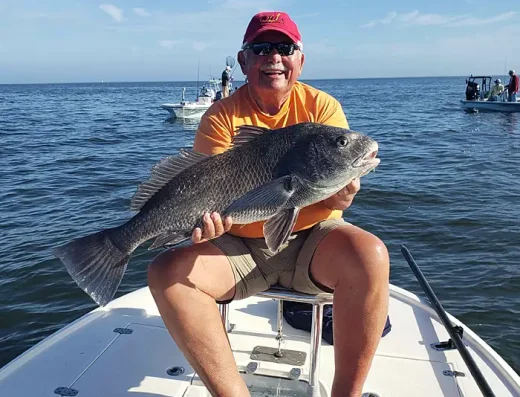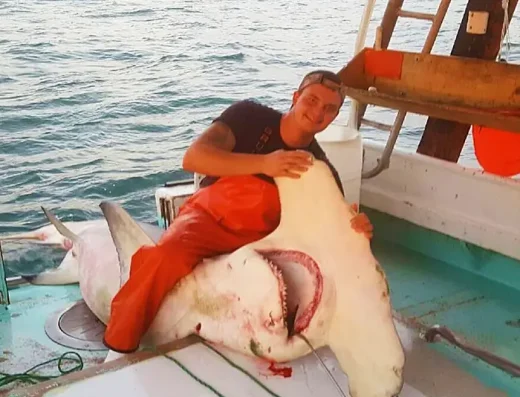New Smyrna Beach Fishing Charters
New Smyrna Beach fishing charters work the Indian River Lagoon, Ponce Inlet, and nearshore Atlantic waters for redfish, speckled trout, snook, tarpon, and seasonal offshore species.
Top Rated Charters in New Smyrna Beach
TrustedFish connects anglers with proven local captains in New Smyrna Beach, Florida —no commissions, no pay-to-play listings, no BS. Every charter on our platform is invite-only, vetted for skill, local knowledge, and reputation. If they’re listed, they’ve earned it.
New Smyrna Beach, FL Fishing Guide
New Smyrna Beach sits between the Indian River Lagoon and the Atlantic, giving anglers two distinct fisheries within minutes of the ramp. Inshore charters typically launch from Edgewater Public Boat Ramp, North Causeway Boat Ramp, or River Deck Marina. These trips work the mangrove shorelines, grass flats, and channel edges for redfish, spotted seatrout, and snook. Ponce Inlet provides a mix of structure fishing—jetties, rock piles, and tide rips—where you can hook sheepshead, flounder, and even tarpon during the warm months.
Nearshore runs usually stay within 10 miles, targeting kingfish, cobia, and bonito around bait pods or wrecks. Offshore charters, often departing from nearby ports like Daytona or Port Canaveral, run 20–50 miles for mahi, sailfish, and snapper. Half-day inshore trips are common for sight-casting redfish on the flats or drifting live shrimp under popping corks. Full-day trips can combine inshore and nearshore, especially in summer when bait is thick along the beach.
The fishery shifts with the seasons—winter brings clear water and slower presentations, spring fires up the flats, summer sees big bait pushes and pelagics close to shore, and fall often means aggressive inshore bites before the first cold fronts. Light tackle spin gear is standard, with fly fishing offered for tailing reds or laid-up tarpon. Techniques range from live bait drifting and freelining mullet, to jigging soft plastics, trolling spoons offshore, or bottom fishing reefs.
The Indian River Lagoon here is part of one of the most biologically diverse estuaries in North America, and Ponce Inlet connects it to the Gulf Stream influence offshore. If weather’s up, nearby Mosquito Lagoon offers a protected alternative with world-class sight fishing.
Fishing Seasons in New Smyrna Beach
Spring (March–May)
Water temperatures climb, and baitfish flood into the lagoon. Redfish and trout move shallow, feeding aggressively on shrimp and mullet. Ponce Inlet sees more sheepshead on the rocks, and cobia can be found cruising nearshore rays. Offshore trips see mahi starting to move in. Light tackle sight fishing is prime, with fly anglers getting solid shots at tailing fish on calm mornings.
Summer (June–August)
Early mornings are best before the heat and thunderstorms. Tarpon roll along the beaches and inside Ponce Inlet, while snook stack up on docks and seawalls. Nearshore kingfish, bonito, and Spanish mackerel are common around bait pods. Offshore boats run for mahi, sailfish, and bottom species. Live bait slow-trolling and drifting dominates the tactics.
Fall (September–November)
Cooling water sparks aggressive feeding before winter. Schools of redfish gather on the flats, trout numbers improve, and flounder move toward inlet structures. Nearshore waters can see late-season cobia and kings. Offshore, wahoo become more of a target. Casting jigs and swimbaits works well for inshore predators, while slow-pitch jigging and bottom rigs produce offshore.
Winter (December–February)
Clear, calm mornings offer some of the best sight fishing of the year. Redfish and trout hold in deeper holes during cold snaps, then move onto sun-warmed flats mid-day. Sheepshead concentrate on inlet rocks, and black drum school up in the lagoon. Offshore runs depend on weather, but bottom fishing for snapper and grouper is steady. Light, slow presentations with shrimp or scented soft baits work best in the cooler water.
Gamefish in New Smyrna Beach
- Redfish – 18–40 lbs. Sight-fished on lagoon flats year-round; live bait or soft plastics near mangroves and oyster bars.
- Spotted Seatrout – 1–8 lbs. Grass flats and potholes in the lagoon, best in spring and fall with topwaters or live shrimp.
- Snook – 5–20 lbs. Around docks, seawalls, and bridges in summer; caught on live bait or jerkbaits.
- Tarpon – 40–150 lbs. Summer along the beaches and inlet; live mullet, crabs, or fly.
- Sheepshead – 2–8 lbs. Inlet jetties and bridges in winter/spring on fiddler crabs or shrimp.
- Cobia – 20–50 lbs. Nearshore in spring and fall around rays or wrecks; jigs and live bait.
- King Mackerel – 10–30 lbs. Nearshore/offshore summer and fall; slow-trolled live baits or spoons.
- Mahi Mahi – 5–30 lbs. Offshore spring through summer; trolled ballyhoo or lures.
New Smyrna Beach Fishing FAQs
Where do most charters launch in New Smyrna Beach?
Most inshore charters launch from Edgewater Public Boat Ramp, North Causeway Boat Ramp, or River Deck Marina. Offshore trips often stage from nearby Daytona or Port Canaveral for better deep-water access.
How long are typical fishing trips here?
Inshore trips often run 4–6 hours, while nearshore and offshore charters are 6–10 hours depending on distance to the fishing grounds.
What gear is usually provided?
Most charters include rods, reels, tackle, bait, and ice. Fly fishing setups are available on request.
Do I need a fishing license?
When fishing with a licensed charter, you’re covered under the captain’s permit. Private anglers need a Florida fishing license.
What’s the best time of year to fish New Smyrna Beach?
Spring and fall offer consistent action inshore and nearshore, while summer is peak for tarpon and offshore pelagics.
What techniques work best here?
Sight-casting, live bait drifting, slow-trolling, and jigging are all effective depending on season and target species
Which species are most common?
Redfish, seatrout, snook, tarpon, sheepshead, kingfish, and seasonal offshore mahi and cobia are top catches.
How many anglers can join a trip?
Most inshore skiffs take 2–4 anglers, while larger center consoles and sportfishers can handle 6 or more.
Are night fishing trips available?
Some captains offer night trips for snook and dock-light trout fishing during warmer months.



